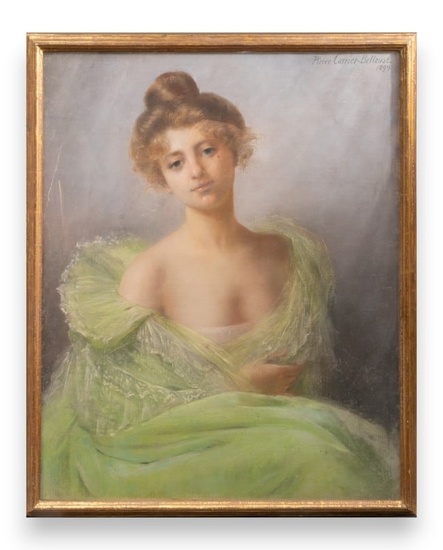Signed Pierre Carrier-Belleuse, Pastel on Linen Painting, 1899
Signed Pierre Carrier-Belleuse, Pastel Painting on Linen , 1899
Pierre Carrier-Belleuse (French, 1851-1932), Young beauty in a pale green gown, signed and dated upper right
Until the 1870s, Montmartre, the section of Paris best remembered as the home of the Impressionists, Cubists, and other members of the avant-garde*, was a sleepy little village spotted with windmills. However, as the city expanded in the late nineteenth century, Montmartre was incorporated into its limits and soon became the hub of Parisian nightlife. In 1881, the famed Moulin Rouge opened its doors, delighting its customers with operettas, can-can girls, and dancers. The success of the Moulin Rouge inspired a number of music halls and cafés to spring up, including the Caran d'Ache, the Mirliton, and the infamous Folies-Bergère, and before long the pleasures available there attracted Parisians from all walks of life: workers, artists, the middle class, the demi-mondaine, and aristocrats mingled together in Montmartre's cabarets and dance halls.
Eventually, the neighbourhood's reputation for debauchery and delight inspired painters and writers alike to take up residence there and immortalize its visitors and residents in pictures and words. Among these was Pierre Carrier-Belleuse, the son of the famed artist Albert Carrier-Belleuse.
The versatile painter Pierre Carrier-Belleuse grew successful at painting and drawing under the hand of his famous father. Pierre also studied under Cabanel and Galland at the Ecole des Beaux-Arts* and debuted at the Paris Salon* in 1875. He mastered pastels* (a difficult medium only recently revived by the Impressionist school) rendering genre works, landscapes, historical subjects and the ballet. Other Parisian venues in which he exhibited included the Society of French Artists (1888) and the National Society of Fine Arts (1893-1911). He received an honorable mention for his work in 1887 and a silver medal at the Exposition Universelle* in 1889.
Sight: 36 x 28 in. (91.4 x 71.1 cm.), Frame: 39 x 31 in. (99.1 x 78.7 cm.)
Condition Report: nice
View it on
Estimate
Reserve
Time, Location
Auction House
Signed Pierre Carrier-Belleuse, Pastel Painting on Linen , 1899
Pierre Carrier-Belleuse (French, 1851-1932), Young beauty in a pale green gown, signed and dated upper right
Until the 1870s, Montmartre, the section of Paris best remembered as the home of the Impressionists, Cubists, and other members of the avant-garde*, was a sleepy little village spotted with windmills. However, as the city expanded in the late nineteenth century, Montmartre was incorporated into its limits and soon became the hub of Parisian nightlife. In 1881, the famed Moulin Rouge opened its doors, delighting its customers with operettas, can-can girls, and dancers. The success of the Moulin Rouge inspired a number of music halls and cafés to spring up, including the Caran d'Ache, the Mirliton, and the infamous Folies-Bergère, and before long the pleasures available there attracted Parisians from all walks of life: workers, artists, the middle class, the demi-mondaine, and aristocrats mingled together in Montmartre's cabarets and dance halls.
Eventually, the neighbourhood's reputation for debauchery and delight inspired painters and writers alike to take up residence there and immortalize its visitors and residents in pictures and words. Among these was Pierre Carrier-Belleuse, the son of the famed artist Albert Carrier-Belleuse.
The versatile painter Pierre Carrier-Belleuse grew successful at painting and drawing under the hand of his famous father. Pierre also studied under Cabanel and Galland at the Ecole des Beaux-Arts* and debuted at the Paris Salon* in 1875. He mastered pastels* (a difficult medium only recently revived by the Impressionist school) rendering genre works, landscapes, historical subjects and the ballet. Other Parisian venues in which he exhibited included the Society of French Artists (1888) and the National Society of Fine Arts (1893-1911). He received an honorable mention for his work in 1887 and a silver medal at the Exposition Universelle* in 1889.
Sight: 36 x 28 in. (91.4 x 71.1 cm.), Frame: 39 x 31 in. (99.1 x 78.7 cm.)
Condition Report: nice



